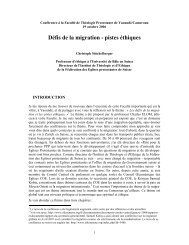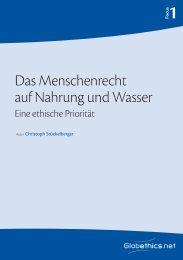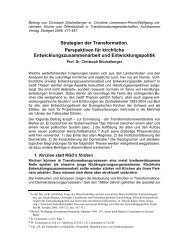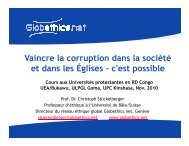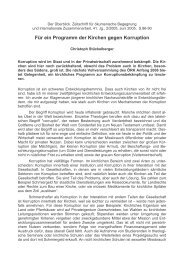BREAK THE CHAINS OF OPPRESION AND THE YOKE OF ...
BREAK THE CHAINS OF OPPRESION AND THE YOKE OF ...
BREAK THE CHAINS OF OPPRESION AND THE YOKE OF ...
You also want an ePaper? Increase the reach of your titles
YUMPU automatically turns print PDFs into web optimized ePapers that Google loves.
world: the oppressed, the poor, the marginalized people. How do they become<br />
agents of change? Do we sufficiently understand the dehumanizing aspects of<br />
poverty, of oppression, of injustice? 21<br />
Liberation and hope<br />
HopE<br />
The starting point for a theology of hope lies in the meaning of the cross and the<br />
resurrection of Christ. In the person of Christ, the age to come, which alone will<br />
endure for all eternity, has arrived. It arrived in his person and was redemptively<br />
present in his work on the cross. The cross of Christ is the judgment of the end<br />
of time now exhausted within time. For the people of God the ‘end time’ judgment<br />
has already happened. ‘Empire’ has already been conquered. The cross of<br />
Christ is the ultimate judgement on the powers in this world. This radical message<br />
means that we are liberated from all powers. We do not depend on them.<br />
We are free. Christian hope means learning to live in freedom. We are also freed<br />
of the burden to realize salvation in this world or to even change the world. The<br />
church does not change the world. The church proclaims that this world and its<br />
powers have been judged by the death and the resurrection of Christ. “And having<br />
disarmed the powers and authorities, he made a public spectacle of them, triumphing<br />
over them by the cross’’ (Colossians 2: 15). This creed is the most radical<br />
criticism of ‘Empire-like’ powers. Are these just words? The church lives<br />
from this reality and in doing so she gives shape to this new era. That is why the<br />
proclamation of the realm of Christ will inevitably lead to ‘signs’ in which the<br />
new reality of the Reign of God becomes apparent. Moltmann calls these signs<br />
‘anticipations’ : they are sacraments of God’s real presence in reality. 22 These<br />
sacraments are provisional: � � they �remind us of the �eschatological � reality, but they<br />
are not that reality itself. They also have a character of ambiguity. The road towards<br />
the future is not linear and progressive. This has also to do with the character<br />
of the eschatological reality itself. God’s reign is not the reality present at<br />
the end of the road of human history. The eschaton is not the result of human<br />
enterprise and or the efforts of the church as the resurrection of Christ is not the<br />
foundation for the progress of history. It is on the contrary the ultimate crisis of<br />
history. The cross and the resurrection of Christ point to the eschaton as the<br />
transcendent reality of God, breaking in in our history. We should also notice<br />
that the signs or the sacraments of the Reign of God bear the shape of the cross.<br />
Not only because they are controversial and critical, but also because the charac-<br />
21 An impressive view on this reality can be found in T.A. Mofokeng, The crucified<br />
among the crossbearers, Towards a Black Christology, Kampen, 1983<br />
22 J. Moltmann, Theologie der Hoffnung, 314.<br />
�����������������������������������������<br />
� � � � � � � ���������������<br />
�<br />
– <strong>THE</strong>OLOGY <strong>OF</strong> HOPE IN TIMES <strong>OF</strong> GLOBALIZATION – 67



